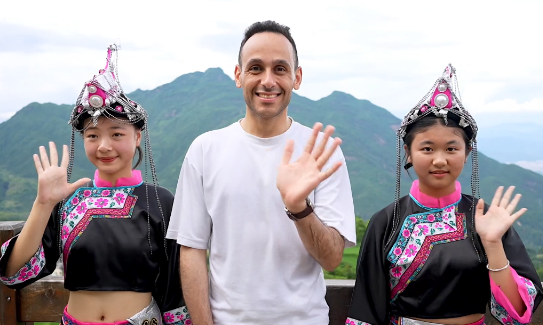Tea sales putting spring in step of farmers, traders
Mingqian leaves attract new fans with unique flavor and exclusive availability
Despite a modest price rise, the seasonal flavor of Mingqian tea is still highly sought-after this year.
Mingqian tea refers to tea sprouts harvested before Qingming, which is a spring solar term in the Chinese lunar calendar and generally falls in early April. The tea is famous in China for its limited output and outstanding quality.
"Every year I look forward to tasting Mingqian tea. Its flavor reminds me of hope and renewal in springtime," said Chen Yan'an, an avid tea drinker.
A report released by the China Tea Marketing Association recently showed that the overall quality of spring tea this year is better than 2022's because of the lower precipitation in winter and spring.
Tea leaves with less water can absorb more nutrients and result in a richer flavor, the report said.
Meanwhile, China's major tea producers including Zhejiang, Hunan and Jiangsu provinces have seen a booming market, according to the report. Compared with recent years, the sales of fresh tea leaves have increased by 30-50 percent.
Many tea merchants, such as Beijing-based Wuyutai and Zhangyiyuan, have reported a rise in bookings for Mingqian tea, even if the price has climbed slightly.
The market of Mingqian tea has almost recovered to the 2019 level and there was a remarkable increase in per-customer transactions compared with 2021-22, said Li Baojie, owner of a Wuyutai outlet in Beijing's Dongcheng district.
A highlight is that Mingqian tea gift sets sold very well this year, partly because people are attending more social events after travel restrictions were lifted, several tea merchants said.
Behind the thriving market of Mingqian tea is people's greater recognition of traditional Chinese culture, industry insiders said.
China is known as the home of tea. Chinese started to drink tea during the Western Han Dynasty (206 BC-AD 24), as evidenced by remains unearthed from Yangling, the tomb of Emperor Liu Qi (188-141 BC)
In November 2022, China's traditional tea-processing techniques and associated social practices were included on UNESCO's Representative List of the Intangible Cultural Heritage of Humanity.
Thanks to the country's emphasis on cultural confidence, tea culture has gained popularity in recent years among young people. They appreciate tea not just for its taste but for the elegance and beauty of tea ceremonies.
The hit costume drama A Dream of Splendor, which was released in 2022, ignited young people's enthusiasm for tea culture. The series depicts the hustle and bustle of urban life during the Song Dynasty (960-1279), making traditional tea artistry known to more people.
Many tea producers therefore ramped up efforts to promote the integrated development of tea and tourism industries, while some historical spots have launched tea culture-related activities to attract tourists.
Covering about 333 hectares, the Chunqing tea farm in Nanjing's Gaochun district allows visitors to experience tea-picking and processing, while offering them tea ceremony performances.
In the springtime, flocks of tourists come to the garden to admire the beautiful scenery and enjoy a cup of fresh tea, said Zhao Jianming, manager of the tea farm. He added that the highest daily visitor number can reach 2,000 during holidays.
The farm's major products are Biluochun, literally "green spiral spring", according to Zhao. The tea is characterized by its spiral-like appearance covered with some white fuzz. When it's brewed, the water turns a vivid green and gives off a strong aroma.
zhanglinwan@chinadaily.com.cn
-
Foreign teacher, Hangzhou students capture picturesque countryside
August 9, 2023
-
Hangzhou Asian Games launch 50-day-to-go campaign
August 4, 2023
-
Hangzhou achieves 6.9% GDP growth in H1 2023
July 27, 2023



